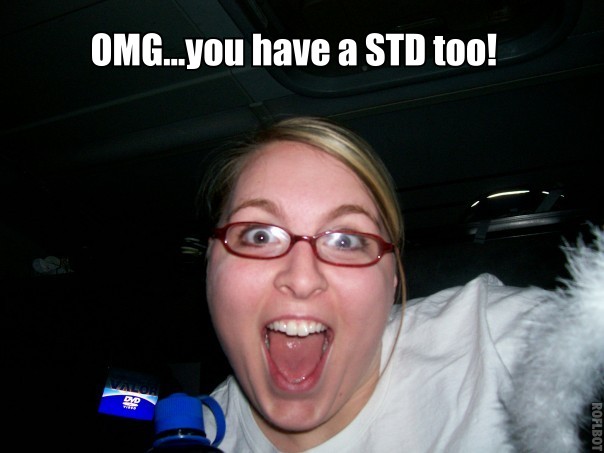3 Answers
HPV can cause oral cancer. Go here for more information > http://www.entusa.com/hpv_&_oral_cancer.htm
Substantial evidence is mounting that the Human Papillomavirus or HPV is playing an increasing important role in oral cancer. On the rise are cancers of the tonsils and base of tongue. Infections with HPV-6 and HPV-11 are known causes of genital warts and cervical cancer(1) . It has been shown that 70% of cervical cancers are caused by HPV-16 and HPV-18. Frisch and Biggar (2) reported that patients with anogenital squamous cell carcinoma had a 4.5 increased risk of developing tonsillar cancer.
| 13 years ago. Rating: 9 | |
Does it look like it to you???>http://www.cdc.gov/STD/HPV/STDFact-HPV.htm
Genital HPV Infection - Fact Sheet
What is genital HPV infection?
Genital human papillomavirus (also called HPV) is the most common sexually transmitted infection (STI). There are more than 40 HPV types that can infect the genital areas of males and females. These HPV types can also infect the mouth and throat. Most people who become infected with HPV do not even know they have it.
HPV is not the same as herpes or HIV (the virus that causes AIDS). These are all viruses that can be passed on during sex, but they cause different symptoms and health problems.
What are the signs, symptoms and potential health problems of HPV?
Most people with HPV do not develop symptoms or health problems from it. In 90% of cases, the body’s immune system clears HPV naturally within two years. But, sometimes, HPV infections are not cleared and can cause:
Genital warts
Rarely, warts in the throat -- a condition called recurrent respiratory papillomatosis, or RRP. When this occurs in children it is called juvenile-onset RRP (JORRP).
Cervical cancer and other, less common but serious cancers, including cancers of the vulva, vagina, penis, anus, and oropharynx (back of throat including base of tongue and tonsils).
The types of HPV that can cause genital warts are not the same as the types that can cause cancers. There is no way to know which people who get HPV will go on to develop cancer or other health problems.
Signs and symptoms of HPV-related problems:
Genital warts usually appear as a small bump or group of bumps in the genital area. They can be small or large, raised or flat, or shaped like a cauliflower. Health care providers can diagnose warts by looking at the genital area during an office visit. Warts can appear within weeks or months after sexual contact with an infected partner—even if the infected partner has no signs of genital warts. If left untreated, genital warts might go away, remain unchanged, or increase in size or number. They will not turn into cancer.
Cervical cancer usually does not have symptoms until it is quite advanced. For this reason, it is important for women to get regular screening for cervical cancer. Screening tests can find early signs of disease so that problems can be treated early, before they ever turn into cancer.
Other HPV-related cancers might not have signs or symptoms until they are advanced and hard to treat. These include cancers of the vulva, vagina, penis, anus, and oropharynx (back of throat including base of tongue and tonsils). For signs and symptoms of these cancers, see https://www.cancer.gov.
RRP is a condition in which warts grow in the throat. These growths can sometimes block the airway, causing a hoarse voice or troubled breathing.
How do people get HPV?
HPV is passed on through genital contact, most often during vaginal and anal sex. HPV may also be passed on during oral sex and genital-to-genital contact. HPV can be passed on between straight and same-sex partners—even when the infected partner has no signs or symptoms.
A person can have HPV even if years have passed since he or she had sexual contact with an infected person. Most infected persons do not realize they are infected or that they are passing the virus on to a sex partner. It is also possible to get more than one type of HPV.
Rarely, a pregnant woman with genital HPV can pass HPV to her baby during delivery. Very rarely, the child can develop juvenile-onset recurrent respiratory papillomatosis (JORRP).
How does HPV cause genital warts and cancer?
HPV can cause normal cells on infected skin to turn abnormal. Most of the time, you cannot see or feel these cell changes. In most cases, the body fights off HPV naturally and the infected cells then go back to normal. But in cases when the body does not fight off HPV, HPV can cause visible changes in the form of genital warts or cancer. Warts can appear within weeks or months after getting HPV. Cancer often takes years to develop after getting HPV.
How common are HPV and related diseases?
HPV (the virus). Approximately 20 million Americans are currently infected with HPV. Another 6 million people become newly infected each year. HPV is so common that at least 50% of sexually active men and women get it at some point in their lives.
Genital warts. About 1% of sexually active adults in the U.S. have genital warts at any one time.
Cervical cancer. Each year, about 12,000 women get cervical cancer in the U.S. Almost all of these cancers are HPV-associated.
Other cancers that can be caused by HPV are less common than cervical cancer. Each year in the U.S., there are about:
1,500 women who get HPV-associated vulvar cancer
500 women who get HPV-associated vaginal cancer
400 men who get HPV-associated penile cancer
2,700 women and 1,500 men who get HPV-associated anal cancer
1,500 women and 5,600 men who get HPV-associated oropharyngeal cancers (cancers of the back of throat including base of tongue and tonsils) [Note: Many of these cancers may also be related to tobacco and alcohol use.]
Certain populations are at higher risk for some HPV-related health problems. This includes gay and bisexual men, and people with weak immune systems (including those who have HIV/AIDS).
RRP is very rare. It is estimated that less than 2,000 children get juvenile-onset RRP every year in the U.S.
| 13 years ago. Rating: 7 | |

 semperfi73
semperfi73
 lindilou
lindilou
 Shootah
Shootah





